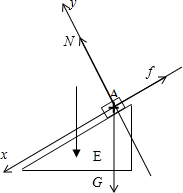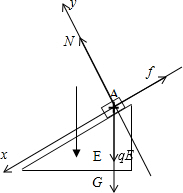问题
多选题
如图所示,带正电物体A在固定的绝缘斜面上下滑,若在斜面上方所在空间加一个竖直向下的匀强电场,且电场强度E随时间t均匀增加,则下列说法正确的是( )
A.若A在无电场时是匀速运动的,则加了电场后仍为匀速运动
B.若A在无电场时是匀速运动的,则加了电场后A物将变加速下滑
C.若A在无电场时是匀加速下滑,则加了电场后仍匀加速下滑
D.若A在无电场时是匀加速下滑,则加了电场后将变加速下滑,加速度逐渐增大

答案
不加电场时,对物体受力分析,受重力、支持力和摩擦力,如图

假设动摩擦因素为μ,根据牛顿第二定律,运用正交分解法,得到
mgsinθ-μmgcosθ=ma
解得
a=gsinθ-μgcosθ ①
加电场后多受一个电场力qE,再次对物体受力分析,如图

根据牛顿第二定律,运用正交分解法,得到
(mg+qE)sinθ-μ(mg+qE)cosθ=ma′
解得
a′=(gsinθ-μgcosθ)+
②qE(sinθ-μcosθ) m
当不加电场物体匀速下滑时,由①式得到μ=tanθ,代入②式得到a′=0,即物体依然匀速,故A正确,B错误;
当不加电场物体匀加速时,由①式得到a>0,由于电场强度随时间均匀增加,由②式可以得到加速度随时间均匀增加,故C错误,D正确;
故选A、D.
